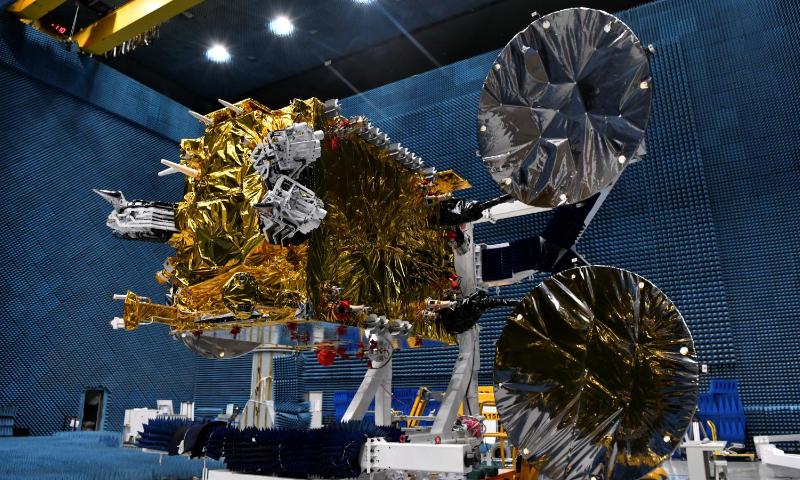
APSTAR-6E Communications Satellite Image: Courtesy of China Academy of Space Technology
Asia-Pacifc-6E, or APStar-6E, China’s first all-electric propulsion communication satellite, has successfully passed in-orbit technology verification and ground station technology review in Hong Kong, which means the satellite after successfully reaching full operation It passed all in-orbit tests on Monday, according to China spacecraft manufacturer Great Wall Industry of China (CGWIC).
As of Monday, all tests outlined in the in-orbit testing protocol had been successfully completed. The APStar-6E payload is operating normally, consistent with ground test results, meeting contractual specifications and in-orbit operational requirements, CGWIC told Global Times Monday in a statement.
Both sets of Hall/Ion electric propulsion systems on the platform met station maintenance requirements, read the statement.
According to CGWIC, by providing cost-effective and high-capacity broadband satellite resources, APStar-6E will help grow the regional information industry and address the digital divide faced by developing regions.
Developed by the China Academy of Spacecraft Technology and developed using the DFH-3E satellite platform, APStar-6E is the first satellite of its kind.
APStar-6E is operated by APT Mobile Satcom Limited based in Hong Kong and operated by APT Satellite Company Limited. APStar-6E focuses on the Southeast Asian market, providing high-capacity and cost-effective broadband connectivity services to the region.
The APStar-6E communications satellite and its autonomous propulsion module were successfully launched on January 13, 2023 by the Long March-2C carrier rocket from the Shichang Satellite Launch Center in Sichuan Province, southwest China.
After separating from the propulsion module on January 23 of the same year, the satellite used the dual Hall/Ion electric propulsion system to autonomously change orbit, reach geosynchronous orbit (GEO) and dock at its test site on June 10, 2024.
The APStar-6E satellite is the new generation of commercial all-electric propulsion satellites in the DFH series, and the first Chinese satellite to achieve autonomous orbit transmission.
After arriving at GEO, the in-orbit test of the APStar-6E went smoothly. Following the completion of the first phase of in-orbit tests on July 9, 2024, the satellite was redeployed to its 134°E operational position, deployed concurrently with the APStar-6C and APStar-6D aircraft.
Equipped with 25 Ku-band user beams and 3 Ka-band gate beams, it has a communication capacity of about 30 Gbps and an in-orbit lifetime of 15 years.
Successful operation of APStar-6E is critical to achieving low-cost high-throughput satellite platforms, enhancing international competitiveness of China’s telecommunications satellite platforms, realizing fully autonomous orbit upgrades and long-term autonomous operations, and improving intelligent autonomy of China’s satellite platforms, according to CGWIC.
CGWIC, a subsidiary of state-owned space giant China for Aerospace Science and Technology (CASC), has so far conducted 13 in-orbit delivery communications satellite programs for international customers, and delivered its communications satellite systems to several countries and regions among them. Nigeria, Venezuela, Pakistan, Bolivia, Laos, Belarus and Algeria.
#Chinas #allelectric #propulsion #communications #satellite #passes #inorbit #tests #fully #operational